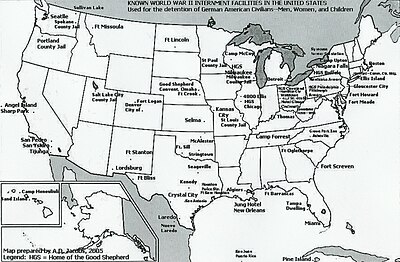
Back Інтэрніраванне немцаў у ЗША Byelorussian Internierung Deutscher in den Vereinigten Staaten während des Zweiten Weltkrieges German بازداشت دستهجمعی آلمانی-آمریکاییها Persian Internement des Germano-Américains French Internamento dei tedeschi negli Stati Uniti Italian Alman asıllı Amerikalıların enterne edilmesi Turkish
 Locations of internment camps for German enemy aliens during World War II | |
| Date | 1917–1919 1939–1948 |
|---|---|
| Location | United States |
| Part of a series on |
| Discrimination |
|---|
 |
Internment of German resident aliens and German-American citizens occurred in the United States during the periods of World War I and World War II. During World War II, the legal basis for this detention was under Presidential Proclamation 2526, made by President Franklin Delano Roosevelt under the authority of the Alien Enemies Act.[1]
With the U.S. entry into World War I after Germany's unrestricted submarine warfare, German nationals were automatically classified as enemy aliens. Two of four main World War I-era internment camps were located in Hot Springs, North Carolina, and Fort Oglethorpe, Georgia.[2] Attorney General A. Mitchell Palmer wrote that "All aliens interned by the government are regarded as enemies, and their property is treated accordingly."
By the time of WWII, the United States had a large population of ethnic Germans. Among residents of the United States in 1940, more than 1.2 million persons had been born in Germany, 5 million had two native-German parents, and 6 million had one native-German parent. Many more had distant German ancestry. During WWII, the United States detained at least 11,000 ethnic Germans, overwhelmingly German nationals between the years 1940 and 1948 in two designated camps at Fort Douglas, Utah, and Fort Oglethorpe, Georgia.[3][4] The government examined the cases of German nationals individually, and detained relatively few in internment camps run by the Department of Justice, as related to its responsibilities under the Alien Enemies Act. To a much lesser extent, some ethnic German US citizens were classified as suspect after due process and also detained. Similarly, a small proportion of Italian nationals and Italian Americans were interned in relation to their total population in the US. The United States had allowed immigrants from both Germany and Italy to become naturalized citizens, which many had done by then.
In the early 21st century, Congress considered legislation to study treatment of European Americans during WWII, but it did not pass the House of Representatives. Activists and historians have identified certain injustices against these groups. Unlike Italian Americans and Japanese Americans, German American internees have never received financial compensation or an official apology for these events.
- ^ "The Alien Enemies Act Presidential Proclamations, German American Internee Coalition". Archived from the original on 2015-12-15. Retrieved 2015-12-10.
- ^ The U.S. Confiscated Half a Billion Dollars in Private Property During WWI, America’s home front was the site of internment, deportation, and vast property seizure, Smithsonian Magazine
- ^ Kramer, William (12 April 1989). "A Sordid Time in Our History: Internment of Japanese Americans after Pearl Harbor". L.A. Daily.
- ^ Ebel, Karen E. (March 2005). "German-American Internees in the United States during WWII". Traces. Archived from the original on February 26, 2016. Retrieved March 1, 2016.
© MMXXIII Rich X Search. We shall prevail. All rights reserved. Rich X Search